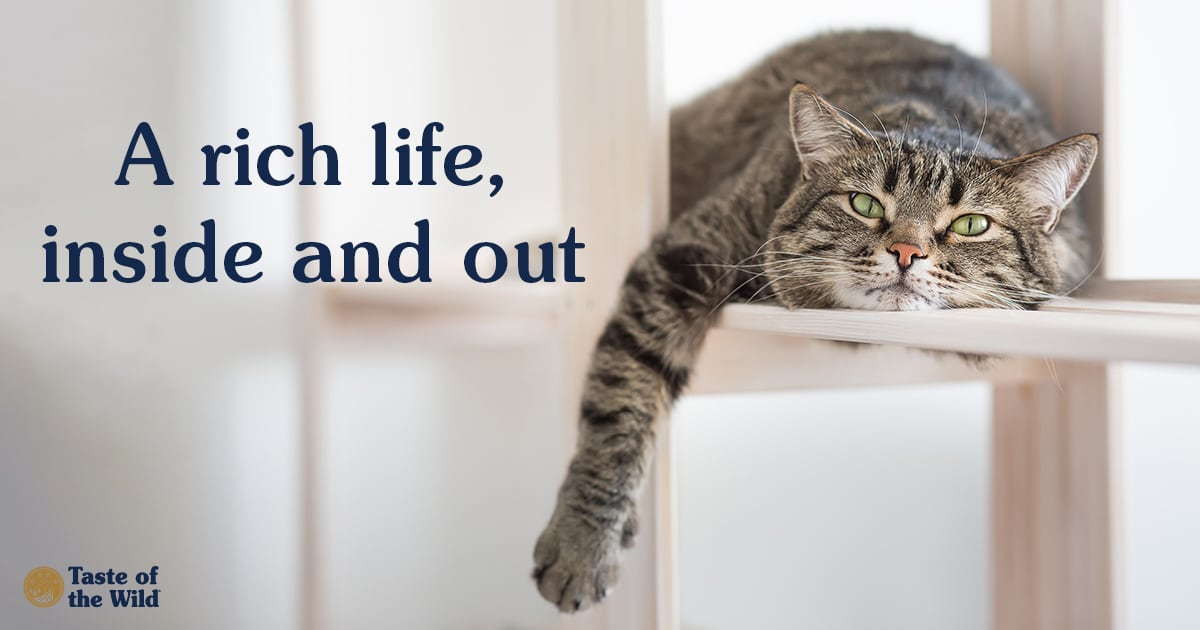
Life may seem a lot easier for indoor cats than their outdoor counterparts. Indoor cats don’t have to lift a paw to receive tasty, nutritious meals. They can snuggle in a warm bed in the middle of a blizzard. And they never have to worry about dodging cars or ferocious animals.
But the truth is, indoor cats need to express a lot of the natural instincts and behaviors like hiding, hunting, scratching and scent marking that outdoor cats accomplish organically. When deprived of these outlets, indoor cats can become stressed, potentially leading to illness and unwanted behaviors.
As part of National Cat Health Month, we’re sharing indoor cat enrichment tips to help you make sure your indoor kitty is as happy and comfortable as possible.
Make your cat feel more at home
Understanding your cat’s needs can help you make small changes that will have a big impact on his or her well-being. Here are a few examples:
A private sanctuary — As the actress Greta Garbo famously quipped, “I want to be alone.” Cats seek private time, too. Cats cope with noisy workmen, overzealous children and other household pets by escaping to a place where they can hide and feel safe. Ideally, provide each cat with a quiet room where it can sleep without feeling vulnerable. If possible, include a bed or box for hiding, food and water bowls, toys and other resources your cat may need.
A bird’s eye view — Many cats prefer to survey their kingdom from above. Cat trees and perches that attach to the wall or windowsill offer the opportunity to climb and observe the world from a safe place. Even better, position the cat tree near a window where your feline can keep an eye on the bird feeder outside.
The right litter boxes — Cats can be particular about their litter box preferences. As a rule of thumb, there should be one litter box per cat in the household, plus one more. Boxes should be about one and a half times the length of the cat (excluding the tail). Cats generally prefer uncovered boxes with unscented, scoopable litter. Boxes should be placed in private but easily accessible locations. You should clean litter at least once a day, and wash the box with mild dish soap once a week.
Physical and mental stimulation — Although cats often like routine, monotony can cause stress and lead to illness and behaviors such as overgrooming. Take time each day to get your cat moving, whether it’s a game of fetch or a laser pointer chase. Some cats can even be trained to walk on a leash. Food puzzles can help stimulate your cat’s mind and make them work for each meal. Toys should be rotated on a regular basis to keep things fresh.
Something to scratch — Cats like to scratch to shed dried nail husks and sharpen their nails. But even declawed cats need to stretch and mark the area with pheromones from the scent glands in their paws. Providing vertical or horizontal scratching posts can provide cats with a suitable place to flex their paws.
An opportunity to hunt — Cats rarely tire of the thrill of the chase. Help your cat express their predatory instincts with toys that mimic the hunting experience. Wands with feathers and bells, toys that squeak or race across the floor all give your cat a chance to stalk and pounce. Finish the game with treat rewards to satisfy the experience of eating prey.
Personal space — In multiple-cat households, competition for resources such as the litter box, food or toys can cause anxiety. Make sure to distribute these items around the house so cats have an opportunity to enjoy them without another cat (or dog) pushing them out of the way.
By minimizing stress and helping your cat express its natural behaviors, you can strengthen the bond between you and your indoor feline companion.
The information in this blog has been developed with our veterinarian and is designed to help educate pet parents. If you have questions or concerns about your pet's health or nutrition, please talk with your veterinarian.
